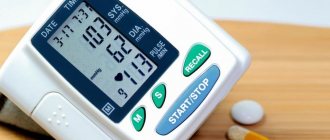Low blood pressure and low pulse are not so uncommon. The development of this condition can be due to reasons of both physiological and pathological nature. When severe hypotension (low blood pressure) and bradycardia (low heart rate) are combined, the blood supply to organs and tissues deteriorates, which leads to the development of hypoxia, hypoxemia, and ischemia. In turn, these disorders can cause serious illness and even death. Therefore, it is important to know what to do if you have low blood pressure and low heart rate.
If the blood pressure is low and the pulse is low, the patient is given an ECG.
Blood pressure and pulse
Blood pressure (BP) is the force with which blood acts on the walls of the arteries. This is one of the important indicators of hemodynamics.
The pulse is the jerky vibrations of the artery walls caused by the movement of blood pushed out by the heart. Typically, pulse examination is carried out on the radial artery, but other superficial arteries (temporal, carotid, femoral) are also excellent for this purpose.
If the pulse rate drops to 40 beats per minute or less, then an ambulance should be urgently called to the patient.
Normally, an adult's heart rate ranges from 60 to 90 beats per minute. A pulse of less than 60 beats per minute is called bradycardia, and its decrease to 50 beats per minute or less poses a threat to human life and health.
Normal daily blood pressure readings are:
- systolic (upper, cardiac) pressure – 91–139 mm Hg. Art.;
- diastolic (lower, renal) – 61–89 mm Hg. Art.
Low blood pressure is called hypotension.
Diagnostics
Often, an increased pulse with low blood pressure is observed in older people due to age-related changes in the condition of blood vessels and the heart. The walls of the capillaries become brittle and lose elasticity, which is why they cannot fully contract and regulate blood pressure levels on their own. However, similar symptoms are observed in young patients, and an attack of a drop in upper pressure is accompanied by nausea, vomiting, weakness and dizziness.
It is not possible to determine the exact causes of the described condition on your own; you need to contact a specialist. Comprehensive diagnostics usually includes:
- Blood tests - general and biochemical composition. The second method of examination is necessary if poisoning by toxic substances is suspected, and general indicators will make it possible to diagnose inflammatory processes, iron deficiency anemia and other hidden diseases.
- X-ray examination is necessary to detect inflammation of the lungs, the formation of stones in the kidneys, gall bladder, because for these reasons the pulse increases simultaneously with a decrease in blood pressure quite often.
- Echocardiogram – necessary to detect changes in the structure of the heart muscle and valves. It also allows you to evaluate the work of the heart, whether there are signs of damage and impaired contractility. The examination is safe even for a child, since it is carried out using ultrasound.
- A blood test for hormone levels and an analysis for the content of specific immunoglobulins are recommended if problems with the thyroid gland (thyrotoxicosis, hypothyroidism) and a tendency to allergic reactions are suspected.
Performing an ultrasound of the heart
To track the onset and possible causes of rapid heartbeat against the background of low blood pressure, daily monitoring of indicators is carried out. This allows you to establish the time of heart rate surges and identify predisposing factors (physical activity, anxiety, etc.).
Low blood pressure and low pulse: causes
The combination of hypotension and bradycardia may not be associated with any diseases, but caused by physiological factors.
- Hypothermia. Low temperature reduces the need of tissues for oxygen and nutrients, so the heart begins to work less intensely, which leads to a decrease in blood pressure and a decrease in heart rate.
- Pregnancy. In the third trimester of pregnancy, the fetus begins to compress the inferior vena cava. As a result, blood flow to the heart decreases, which in turn causes a decrease in cardiac output. Clinically, this leads to a sharp drop in pressure and bradycardia.
- Professional sports. In well-trained people at rest, there is a decrease in breathing rate, heart rate, and blood pressure, which is a variant of the physiological norm.
Why is low blood pressure with low heart rate a deviation? The reasons are as follows:
- coronary heart disease (angina pectoris, myocardial infarction, post-infarction cardiosclerosis);
- atherosclerosis of the coronary arteries;
- weakness of the sinus node;
- congenital anomalies of the anatomical structure of the heart.
When severe hypotension and bradycardia are combined, the blood supply to organs and tissues deteriorates in a person, which leads to the development of hypoxia, hypoxemia, and ischemia.
What does a sharp decrease in blood pressure and a drop in heart rate indicate? This is usually observed against the background of critical, life-threatening sick conditions:
- thromboembolism of the pulmonary artery or its major branches (PE);
- collapse or fainting;
- some acute poisonings;
- severe infectious diseases;
- generalized allergic reactions;
- heart rhythm disturbances;
- acute myocardial infarction.
First aid and further actions for a patient with bradycardia and hypotension
The algorithm of action depends on the frequency of occurrence of symptoms, their intensity and the cause of low blood pressure and frequent low pulse. Typical clinical picture: headache, dizziness, drowsiness in the middle of the day, loss of consciousness, nausea; Vomiting, cold sweat, shortness of breath, and swelling may occur.
Treatment primarily depends on the severity of the symptoms. This can be found out by visiting a doctor. The range of possible diagnostic procedures includes anamnesis, objective examination (measurement of pulsation, pressure, assessment of the state of the cardiovascular system), general tests (possible anemia, which is manifested by a lack of hemoglobin and red blood cells), ECG, Holter monitoring, chest x-ray and additional studies depending on comorbidities.
If this condition does not cause much discomfort, you can take a cup of strong green tea for low blood pressure and low pulse. This increases blood pressure and tones blood vessels. A variety of tinctures have a positive effect: ginseng, belladonna, eleutherococcus.
For chronic cases, medications are used: Citramon, Zelenin tincture.
There is a special conduction system in the heart that ensures the excitability and automaticity of the heart. Contractions above 60 times per minute are provided by the sinus node (which normally plays the role of a first-order pacemaker). When it weakens, the underlying structures perform the pacemaker function, which contributes to bradycardia. For this pathology, surgical intervention and installation of an electrical pacemaker are adequate, which ensures the heart rate at the required level.
You should not forget to monitor your pulse and blood pressure during an attack, since a decrease in heart rate (HR) below 40 is fraught with cardiac arrest, so readings less than 50 or resistance to home treatment are indications for calling an ambulance.
Critical conditions that may be accompanied by hypotension and bradycardia:
- Pulmonary embolism (blockage of a vessel with a blood clot, resulting in acute respiratory failure). In such a case, it is necessary to carry out anticoagulant therapy with heparin or its analogues, thrombolytic therapy (streptokinase, alteplase) and treatment of hemodynamic and respiratory disorders. At the same time, the ability of blood to clot is recorded. To verify the diagnosis, X-rays are taken and D-dimer is measured.
Loss of consciousness and collapse (a critical decrease in blood pressure that requires immediate medical attention and can lead to failure of internal organs). In this case, it all depends on the reason that provoked the attack. First aid is to place the person in a lying position (if this is not already done) and elevate the legs to increase blood flow to the head. Next, drugs such as caffeine-sodium benzoate, mezatone, and adrenaline can be administered. In case of hemorrhagic collapse, it is necessary to stop the bleeding and begin administering blood substitutes, and in case of infectious collapse, infusion therapy, detoxification and elimination of the pathogen are carried out;- Severe allergic reactions (for example, angioedema). These conditions are treated with adrenaline or glucocorticoids, depending on the etiology;
- Condition during anesthesia. Hypotension and bradycardia are common side effects of spinal anesthesia. The main effects are a decrease in preload on the heart, which is combined with bradycardia. Here it is necessary to reduce the depth of anesthesia and replenish the volume of circulating blood. Doctors sometimes resort to the use of vasopressors, atropine and antiarrhythmics - heavy cardiac artillery;
- Myocardial infarction. This pathology requires urgent medical attention. During an attack, there is typical chest pain radiating to the left side of the body. The symptom does not go away and is not relieved by nitroglycerin, the person feels anxiety and fear of death.
Further tactics are to normalize the daily routine, sleep and rest. Eliminate stress and overload, and adequate physical activity, on the contrary, will help improve your condition. You should eat often, in small portions, and drink enough fluids. It is recommended to eat seaweed, seafood, and nuts. A dairy-vegetable diet will be beneficial. The patient should limit the consumption of baked goods and fatty foods.
What are the dangers of a weak pulse and low blood pressure?
If a person has a pulse of less than 50 beats per minute, this should be a reason for a medical examination. To confirm bradycardia, an ECG must be recorded.
If the pulse rate drops to 40 beats per minute or less, then an ambulance should be urgently called to the patient, since this condition can be accompanied by extremely dangerous pathologies:
- atrial fibrillation;
- pulmonary embolism;
- myocardial infarction.
Let's look at what a small pulse and low blood pressure can lead to. A pronounced decrease in heart rate is accompanied by the development of hypoxia, which is manifested by the following symptoms:
- increased fatigue;
- general weakness;
- dizziness and headache;
- fainting conditions;
- severe drowsiness during the daytime;
- pain in the chest area;
- dyspnea;
- cold sweat;
- the appearance of swelling of soft tissues.
Characteristic symptoms
In order to relieve the symptoms of low blood pressure and rapid pulse, it is necessary to promptly recognize a condition that poses a threat to health. Due to circulatory failure, the following symptoms occur:
- fainting;
- lack of coordination in space;
- nausea and vomiting;
- weakness, increased fatigue;
- dyspnea;
- deterioration of visual function.
Dizziness is the most common accompanying drop in blood pressure and increased heart rate
In severe cases, consciousness becomes clouded and generalized convulsions develop, so this condition is considered life-threatening and requires medical intervention. Next, we will talk about first aid measures that need to be provided to the patient before the doctors arrive and the symptoms of tachycardia are relieved.
First aid
The algorithm of action for low pulse and blood pressure is largely determined by how severe these symptoms are.
A pulse of less than 60 beats per minute is called bradycardia, and its decrease to 50 beats per minute or less poses a threat to human life and health.
With minor bradycardia, hypotensive patients can be advised to drink a cup of strong, sweet tea or coffee. These drinks contain caffeine, which increases vascular tone and increases heart rate.
For mild bradycardia and hypotension, some folk remedies (tincture of Eleutherococcus, ginseng or belladonna) also have a good effect.
If prescribed by a doctor, you can take medications containing caffeine (Citramon, Askofen) at home.
If there is a sharp drop in pulse and blood pressure, the patient needs urgent hospitalization. In order to restore his heart rhythm, he is given injections of Atropine sulfate, Alupent, and Izadrina.
Main reasons
A rapid pulse with low blood pressure is not always a dangerous condition and requires urgent medical intervention. The need for treatment and the effectiveness of therapy depend on why the heart rate has increased, as well as on the inverse relationship. That is, does the pressure drop due to an increase in heart rate or does the opposite happen? First, blood pressure decreases, and the heart rate increases.
Both conditions can be caused by different reasons. But more often, tachycardia becomes a secondary factor, manifesting itself as a compensatory reaction of the body to a sharp drop in blood pressure. A condition where a relatively healthy person’s pulse increases with reduced blood pressure is accompanied by hypovolemia. This means that there has been a decrease in the volume of blood circulating throughout the body.
There are two types of pathology:
- True. It manifests itself with blood loss, dehydration or release of blood plasma into the intercellular space - this reduces the amount of blood in the cavity of the vascular bed.
- Relative. It is characterized by pathological vasodilation, in which the blood volume is no longer sufficient to maintain blood pressure levels in a stable state.
In response to insufficient blood volume and a drop in pressure, the heart reacts by increasing the number of contractions to maintain the blood supply to important organs and systems - this is how a condition develops when the pressure is low and the pulse is fast. In this case, both the upper (systolic) and lower (diastolic) pressure drops immediately.
Dehydration
Losing a large amount of fluid from the body often leads to a decrease in blood pressure and an increase in heart rate. Dehydration occurs as a result of diarrhea (poisoning, infectious diseases, enterocolitis and irritable bowel syndrome). The body also loses a lot of fluid due to vomiting, excessive sweating, and after drinking large amounts of alcohol.
In an elderly person, a drop in blood pressure and increased heart rate are often the result of dehydration due to diabetes and the use of diuretics. Diuretics are prescribed to elderly patients to treat hypertension, which occurs in half of patients over 50–60 years of age; they remove excess fluid from the body. And with diabetes, glucose levels in the blood rise, causing the kidneys to produce more urine.
Blood loss
Blood loss is the most common reason why blood pressure drops during tachycardia. A person can lose blood as a result of injuries and inflammatory diseases, such as gastric and duodenal ulcers, hemophilia, malignant neoplasms of the intestine, esophageal varices, and cirrhosis of the liver.
Release of blood plasma into the intercellular space
Circulating blood volume decreases simultaneously with a drop in blood pressure and an increase in heart rate in the case of certain types of diseases. This happens with inflammatory pathologies of the kidneys, heart failure, liver and biliary tract diseases. Blood effusion also occurs after severe burns to the body and a decrease in protein levels in the blood.
Why can blood pressure decrease with tachycardia?
In many patients, the appearance of a rapid pulse causes a sharp decrease in blood pressure levels, that is, an inverse relationship can be traced. With an increased heart rate, the heart ejects less blood because it does not have time to be fully filled with it, which causes the blood pressure level to decrease.
However, this type of tachycardia, when the pulse affects the pressure, is relatively rare. This phenomenon is diagnosed in patients with signs of ischemia or in adolescents with additional congenital pathways of the cardiac conduction system. However, the pressure does not drop when the temperature rises, after physical activity, fear or pain.
Additional reasons
The following pathological conditions of the body may additionally lower blood pressure and increase heart rate:
- iron deficiency anemia, when the amount of hemoglobin and red blood cells in the blood is reduced;
- panic attacks - attacks of uncontrollable anxiety, fear, panic;
- alcohol abuse and addiction to drugs;
- postprandial hypertension (when blood pressure drops sharply after eating food) and orthostatic hypertension (a jump in blood pressure downward with a sharp change in body position in space, mainly when getting up from a sitting or lying position);
- hypoglycemia – insufficient amount of glucose in the blood plasma;
- arterial valve stenosis;
- ingestion of toxic substances into the body (mercury vapor, lead, cyanide);
- thyrotoxicosis is dysfunction of the thyroid gland when it produces a large amount of hormones.
Often, low blood pressure readings are observed during exacerbation of allergies during grass flowering seasons. A person with a tendency to sensitization may feel weakness, shortness of breath, runny nose, lacrimation, his blood pressure drops, and his pulse quickens due to nervous excitement and swelling of the mucous membranes.
Surgical treatment of bradycardia
If conservative treatment in elderly and young people does not lead to an improvement in hemodynamic parameters, then indications for installing a pacemaker arise.
The pulse is usually measured on the radial artery, although it can be on any large, superficially located
Folk remedies
In consultation with the attending physician, therapy for hypotension and bradycardia can be supplemented with herbal medicine. Most often, experts recommend:
- A decoction of St. John's wort, hawthorn and rosehip fruits, and rosea radiola root. The listed plants are mixed in a ratio of 1:1.5:2:2. Three tablespoons of the resulting mixture are poured with two glasses of boiling water and left for 30-40 minutes. Strain and use half a glass 3 times a day.
- Tincture of ginseng root. To prepare it, you need to grind 25 g of ginseng root and pour one liter of good vodka into it. Leave in a dark place for 21 days. Strain. Take 15-20 drops three times a day half an hour before meals. The course of treatment is 2 months.
- A mixture of walnuts and lemon. Grind half a kilo of walnuts and 4 large lemons through a meat grinder. Add 20 g of granulated sugar, 250 ml of sesame oil and one liter of warm boiled water to the resulting mixture. Mix everything well and store in a well-closed container in the refrigerator. Take a tablespoon three times a day.
If a person has a pulse of less than 50 beats per minute, this should be a reason for a medical examination.
What to do: treatment features
Treatment of hypotension with a lower pressure of 60 mm Hg. It is necessary only if your health deteriorates significantly or if unpleasant or painful symptoms appear.
The first step to recovery should be a visit to a general practitioner. He will be able to refer you to more specialized specialists - a cardiologist, endocrinologist, urologist, neurologist. You should also prepare to undergo detailed diagnostics and undergo laboratory tests.
To relieve the symptoms of hypotension, it is necessary to treat the underlying disease that caused it. To alleviate the condition, symptomatic drug therapy is prescribed. Can be used:
- analeptics;
- alpha adrenergic agonists;
- adaptogens;
Also prescribed are medications that include caffeine and can help in a very short time - Citramon, Caffetamine, Saparal. The drugs are recommended in limited dosages so as not to provoke the onset of hypertension.
To stabilize the level of lower pressure, physiotherapy may be recommended - massage, electro-, water- and magnetic therapy, aromatherapy.
In some cases, professional psychological help is necessary.
Prevention
To reduce the risk of cardiovascular disease, it is necessary to lead a healthy lifestyle from a young age, which means:
- rejection of bad habits;
- playing sports;
- proper balanced nutrition;
- adherence to daily routine;
- avoidance of stressful situations.
In conclusion, I would like to emphasize once again that bradycardia and hypotension do not always mean disease. But regardless of this, their appearance requires examination of the patient in order to establish the cause.
Pathological causes of decreased blood pressure
Some diseases and pathological conditions can become factors causing a decrease in diastolic pressure to 60 mmHg. Art. and below. Among them:
- kidney disease with insufficiency of renin synthesis (more often, this is typical hypotension);
- adrenal gland problems with insufficient cortisol synthesis (Addison syndrome);
- pathologies of the thyroid gland (hypothyroidism), pituitary gland;
- early period of a heart attack, stroke;
- TBI;
- disorders of the musculoskeletal system, cervical muscles (fibrosis, myositis, intervertebral hernia);
- anemia;
- massive bleeding;
- tumors of different locations;
- cardiomyopathy;
- severe infections (tuberculosis, syphilis);
- disorders of the gastrointestinal tract (prolonged diarrhea, vomiting);
- mental instability (neuroses, depression).
Hypotension can occur as a consequence of prolonged use of drugs to lower blood pressure prescribed for hypertensive patients, diuretics. This especially often occurs due to self-medication or exceeding prescribed doses.










